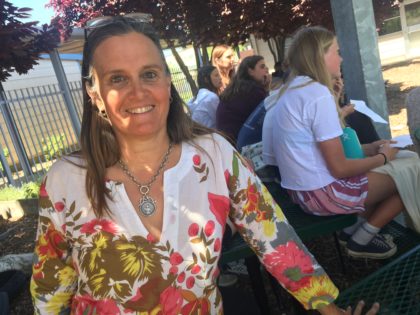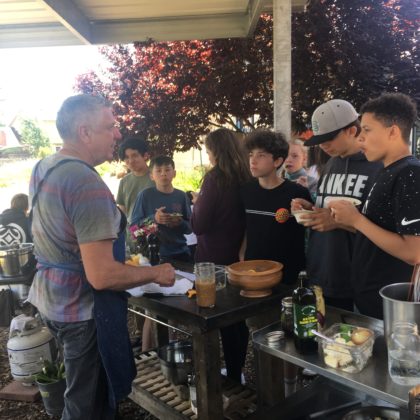While concerns about childhood screen time may keep parents awake at night, Adele Harrison Middle School Garden and Culinary Arts instructor Yannick Phillips has witnessed firsthand how eager many kids are to unplug on their own, opting to go outside to sow seeds, prep beds, choosing shovels to dig trenches over Chromebooks. And then, there’s always the promise of food – homemade and homegrown.
Now in its sixth year, Adele Harrison’s Farm to Table class has become so popular, a second class has been added for the 2019-20 school year.
“In the garden,” Phillips says, “students practice applied problem-solving. They use language, math, science, and teamwork to design and measure out areas, pond depths, and proportions for recipes.” Students invent garden “hacks” such as outdoor dishwashing sinks and trenches for drainage by repurposing materials that are often donated or discarded. Phillips says students must employ “creativity, resourcefulness, and outside-the-box thinking.”
John McReynolds, culinary director of Stone Edge Farm, paid a recent visit to the Adele garden for a cooking demonstration using food picked from the school’s vegetable beds. Thirty or so students watched with rapt attention from chairs and tables surrounding McReynolds and sous chefs Alejandro Crisostomo and Eduardo Haro. They welcomed the students’ questions throughout the class. Stone Edge has been the primary sponsor of the garden since its inception.

“We decided about six years ago to support the middle school gardens,” McReynolds told The Sun. ”It’s a turning point for kids – they are starting to choose a path to follow. It’s a pivotal age.”
For some students, the garden is all about place. “The organic flow of the physical space is well suited to different learning styles and helps kids develop spatial awareness,” said Phillips. “For certain kids who struggle in the classroom, the garden is where they move freely and make their own decisions.”
Phillips believes the garden setting is a counterbalance to the straight lines and uniform surfaces of the indoor spaces. “Being in the garden affords kids opportunities to move on uneven terrain and to navigate space and each other while they are cooking or working.”
The garden is also a popular spot to gather at lunch. Phillips receives between 30 and 50 students each day. When asked why they chose to spend lunchtime in the garden, students answered candidly. “It’s so peaceful.” “It’s quieter and more calming here because of the nature.” “There’s more shade.” “There’s more to do, and more places to sit.” “It’s private.” “We get left alone more.”
McReynolds, who witnessed the lunchtime crowd, reflected during his demonstration, “All these students are here on their lunch break, because it’s an environment that feels nurturing. It’s under the trees, and there are all these flowers. Students are inherently looking for these little places of comfort in the world. A garden can be a place of healing and comfort.” Phillips added, “It’s removed from the central quad of the school. I think students like it because they are exposed to a more natural environment with a greenhouse, shed, raised beds, outside rustic kitchen. Several teachers bring their students outside for activities or reading.”
Phillips says at times she overhears students complaining of stress and anxiety from too much homework and not enough time to rest and unwind, and this worries her. Some kids bring their homework to the garden because they say they are more focused. One student wrote in a letter, “Homework makes students not like school.” Phillips is concerned that the students “seem to have very little downtime to just be outside in nature. They need a place to relax. Kids can both decompress and socialize in the garden while collaborating, for example, on building a pond, group cooking, or painting the new Farm to Table sign.”
The road, according to Phillips, has definitely been bumpy at times. “The bureaucracy can be overwhelming. There seems to be a general lack of understanding in our school system about the importance of a garden in a child’s education. There isn’t a sense that the garden is critical to teaching kids about self-sufficiency and practical life skills like planning, preparation, and celebrating eating together.”
And when the class name was changed from Horticulture to “Farm to Table,” Phillips says it was challenging to communicate that Farm to Table is a farming movement, not just a catchy name for an elective; Farm to Table includes a specific set of guiding principles including locally sourced farm fresh food.

Along with other Sonoma Valley school garden instructors, Phillips attended a training at Edible Schoolyard, a program at MLK Middle School in Berkeley which was started by Chef Alice Waters as a response to what she saw as nutritionally-deficient school lunches. Phillips says, “The training validated the importance of sourcing food close to home, organic, produced without chemicals and fertilizers, and understanding where food comes from. Luckily our sponsor, Stone Edge Farm, gets that, as does Paul’s Produce, also local, who supply us with veggie starts.” Williams Sonoma has also been a supporter.
As trendy as they have become, school gardens are not a new idea. According to education researcher Rob Bowker, “As early as 1909, [Maria] Montessori identified that children’s gardens could be used beyond the standard curriculum to help develop patience, enhance moral education, increase responsibility, and improve appreciation for nature and relationship skills.” While many schools have successful or developing garden programs, California schools struggle to sustain their gardens for a variety of reasons, including lack of training, shortage of water or other resources, turnover and instability among project participants, and lack of time or interest.”

Cooking starts in the garden,” McReynolds says. “You can’t really expect kids to get excited about food if they’re not first excited about being in the garden getting their fingers dirty.”
Solutions to establishing school gardens as integral to the school curriculum and community might also address social justice and climate change, as teachers both find and create new niches and cross-curricular opportunities. Despite the challenges of keeping a school garden running, Phillips loves her job. “It’s great to see kids sitting under the olive tree or on our Adirondack chairs, sipping homemade tea or lemon water. Nurturing the garden helps kids learn to take care of themselves and each other, all while learning.”




One Comment